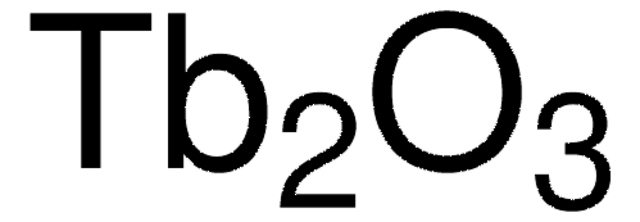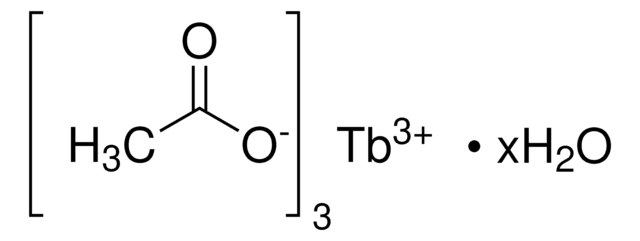325945
Terbium(III)-nitrat Pentahydrat
99.9% trace metals basis
Synonym(e):
Terbium nitrate pentahydrate, Terbium(3+) nitrate pentahydrate
About This Item
Empfohlene Produkte
Qualitätsniveau
Assay
99.9% trace metals basis
Form
solid
Eignung der Reaktion
reagent type: catalyst
core: terbium
Verunreinigungen
≤1500.0 ppm Trace Rare Earth Analysis
SMILES String
O.O.O.O.O.[Tb+3].[O-][N+]([O-])=O.[O-][N+]([O-])=O.[O-][N+]([O-])=O
InChI
1S/3NO3.5H2O.Tb/c3*2-1(3)4;;;;;;/h;;;5*1H2;/q3*-1;;;;;;+3
InChIKey
YWROXJNVUWBEPC-UHFFFAOYSA-N
Allgemeine Beschreibung
Anwendung
- A precursor to prepare Ce-doped terbium aluminum garnets by the photo-induced method.
- A dopant to synthesize emission-tunable luminescent hydroxyapatite probe for bioimaging.
- A starting material to prepare metal-organic frameworks for green laser applications.
Signalwort
Danger
H-Sätze
Gefahreneinstufungen
Eye Irrit. 2 - Ox. Sol. 2 - Skin Irrit. 2 - STOT SE 3
Zielorgane
Respiratory system
Lagerklassenschlüssel
5.1B - Oxidizing hazardous materials
WGK
WGK 3
Flammpunkt (°F)
Not applicable
Flammpunkt (°C)
Not applicable
Persönliche Schutzausrüstung
dust mask type N95 (US), Eyeshields, Gloves, type P3 (EN 143) respirator cartridges
Hier finden Sie alle aktuellen Versionen:
Besitzen Sie dieses Produkt bereits?
In der Dokumentenbibliothek finden Sie die Dokumentation zu den Produkten, die Sie kürzlich erworben haben.
Kunden haben sich ebenfalls angesehen
Artikel
Innovation in dental restorative materials is driven by the need for biocompatible and natural-appearing restoration alternatives. Conventional dental materials like amalgam and composite resins have inherent disadvantages.
Spectral conversion for solar cells is an emerging concept in the field of photovoltaics, and it has the potential to increase significantly the efficiency of solar cells. Lanthanide ions are ideal candidates for spectral conversion, due to their high luminescence efficiencies and rich energy level structure that allows for great flexibility in the upconversion and downconversion of photons in a wide spectral region (NIR-VIS-UV).
The rare earth elements impact nearly everyone in the world. All of the people living in advanced technological countries and almost all those living in third world countries utilize the rare earths in their everyday living—the car that one drives (gasoline is refined from oil using rare earth catalysts and catalytic converters reduce the polluting emissions from the automotive exhaust), watching the news on TV (the red and green colors in TV screens), the telephones and computers we use to communicate (the permanent magnets in speakers and disc drives), just to name a few examples.
Unser Team von Wissenschaftlern verfügt über Erfahrung in allen Forschungsbereichen einschließlich Life Science, Materialwissenschaften, chemischer Synthese, Chromatographie, Analytik und vielen mehr..
Setzen Sie sich mit dem technischen Dienst in Verbindung.
















